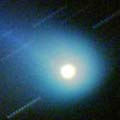
|
The brightening evolution had been slower than a typical comet since its discovery until the perihelion passage in early April. In March when it was finally observable in the Northern Hemisphere, it suddenly became bright and large as 7.8 mag and 6 arcmin (Mar. 8, Seiichi Yoshida), however, the brightening stopped after that. Actually, it is 8 mag still now in the southern sky. However, it is unusual that the brightness by CCD observation was also 8.0 mag (Apr. 4, Ken-ichi Kadota), very similar to the visual observations. It turns to be fading after this. It keeps observable for a long time in the Southern Hemisphere after this. However, it is not observable in the Northern Hemisphere until late September when it appears very low sky at dawn as 14 mag. Unusually strong non-gravitational parameters are revealed by the orbital calculation, but the reason has not been revealed yet.
Date(TT) R.A. (2000) Decl. Delta r Elong. m1 Best Time(A, h)
Apr. 23 0 2.51 -31 9.8 1.082 0.922 52 7.9 3:47 (295,-19)
Apr. 30 0 57.56 -36 0.8 1.099 0.979 55 8.1 3:37 (296,-28)
|
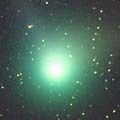
|
It was fantastic, so bright as 3.5 mag, so large as 30 arcmin, locating high overhead at its best time in early January. Then it has been getting fainter and smaller gradually, and 7.6 mag now (Apr. 14, Toni Scarmato). Although it became too faint to see with naked eyes, it is still easy to see with binoculars because moderately condensed as DC=5. It looks rather small with a diameter of about 10 arcmin. It is visible all night in the Northern Hemisphere. In the Northern Hemisphere, it keeps observable in good condition for a long time while the comet is bright enough visible visually until October when it becomes faint as 14 mag. It will be bright at 8.5 mag, so people can enjoy it with binoculars still in May.
Date(TT) R.A. (2000) Decl. Delta r Elong. m1 Best Time(A, h)
Apr. 23 12 1.42 65 31.1 1.336 1.790 98 8.2 21:55 (180, 60)
Apr. 30 12 10.16 61 45.8 1.422 1.864 98 8.5 21:36 (180, 64)
|
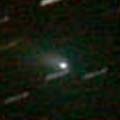
|
In January when it was visible in the Northern Hemisphere, it was an 11 mag small object. However, after it has gone to the southern sky, a very large appearance, 9.2 mag and 8 arcmin, was observed on Feb. 14 (David Seargent). The size became a bit smaller after that, about 3-5 arcmin, however, it keeps 8.0 mag, bright enough to be visible with binoculars, from March to April (Mar. 4 and Apr. 7, Alexandre Amorim). It is very low even in the Southern Hemisphere until mid May. Then it will be higher again, and keeps observable while fading gradually. In the Northern Hemisphere, it is not observable until June when it appears in the morning at 12.5 mag.
Date(TT) R.A. (2000) Decl. Delta r Elong. m1 Best Time(A, h)
Apr. 23 1 48.48 -26 10.6 1.475 0.936 38 8.7 3:47 (278,-38)
Apr. 30 1 51.40 -21 38.4 1.555 0.974 37 9.0 3:37 (275,-33)
|
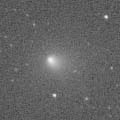
|
It was not visible visually still in February, fainter than 13.9 mag (Feb. 5, Seiichi Yoshida), however, it finally began to be visible visually at 13.3 mag in March (Mar. 1, Juan Jose Gonzalez). Now it is already so bright as 11.3 mag (Apr. 12, Toni Scarmato). Very strongly condensed, and easy to see. It is brightening rapidly, but fainter than originally expected by 0.5 mag. It will reach to 10 mag in spring and summer. It may become a naked-eye object due to the Deep Impact mission on July 4.
Date(TT) R.A. (2000) Decl. Delta r Elong. m1 Best Time(A, h)
Apr. 23 13 3.21 12 33.3 0.720 1.672 150 10.9 22:56 ( 0, 67)
Apr. 30 12 58.07 11 40.0 0.713 1.644 145 10.7 22:23 ( 0, 67)
|

|
It will reach to 10 mag in June and July. It keeps locating rather low in the morning until that. It has been brightening, and already bright as 14.0 mag by CCD observation (Apr. 8, Ken-ichi Kadota). But actually, it is fainter than its previous return by about 1 mag. It should be already 13 mag visually, but nobody has succeeded to observe it visually yet. It was not visible on Apr. 5, fainter than 12.4 mag (Seiichi Yoshida). However, Rob Matson reported that it became visible on SWAN images on Apr. 22, which implies the comet is already bright as 10.5-11 mag.
Date(TT) R.A. (2000) Decl. Delta r Elong. m1 Best Time(A, h)
Apr. 23 22 13.25 15 52.5 1.714 1.414 55 12.2 3:47 (270, 29)
Apr. 30 22 39.18 17 45.9 1.651 1.355 55 11.8 3:37 (267, 28)
|

|
It was bright as 7.5 mag in early January, easy to see with binoculars. However, it faded and got diffused rapidly in the evening sky since that. It faded to 10.7 mag on Mar. 15 visually (Alexandre Amorim), and 11.5 mag on Apr. 4 by CCD observation (Mitsunori Tsumura), then it became too low. Although it became faint very quickly, the fading pace was slower than usual. It will be unobservable soon even in the Southern Hemisphere. It will appear in the morning sky again in August. It may be still brighter than 14 mag at that time and visible visually.
Date(TT) R.A. (2000) Decl. Delta r Elong. m1 Best Time(A, h)
Apr. 23 3 51.19 -7 38.6 3.748 2.964 33 12.0 20:09 ( 87, -9)
Apr. 30 3 55.07 -6 48.9 3.871 3.044 30 12.2 20:17 ( 92,-15)
|

|
It was 18.5 mag in mid January. The brightening was slower than expected. Although it is not observable now, the ephemeris says it must be brightening rapidly. It is expected to reach to 8 mag from July to August. It keeps unobservable for some more while. In the Northern Hemisphere, it will appear at dawn at 11.5 mag in late May, then it keeps observable for a long time after that. In the Southern Hemisphere, it only appears in the morning very low sky from late April to mid June, but not observable when the comet is bright.
Date(TT) R.A. (2000) Decl. Delta r Elong. m1 Best Time(A, h)
Apr. 23 0 53.05 4 38.9 2.423 1.508 18 12.7 3:47 (257,-10)
Apr. 30 0 58.47 8 26.6 2.333 1.460 23 12.4 3:37 (256, -5)
|
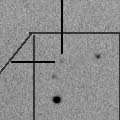
|
The condition of this return is bad. It is not observable around the perihelion passage. It will appear at dawn in July at 14.5 mag, then it will be fading after that.
Date(TT) R.A. (2000) Decl. Delta r Elong. m1 Best Time(A, h)
Apr. 23 0 51.70 -1 42.1 2.467 1.586 22 12.8 3:47 (263,-13)
Apr. 30 1 10.31 -0 8.0 2.480 1.618 24 12.9 3:37 (261,-13)
|
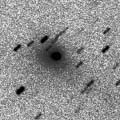
|
It was 12.9 mag on Apr. 9 (Juan Jose Gonzalez). It keeps 12.5-13.0 mag since November, however, now it is smaller and a bit fainter than last autmun while going away from the earth. It keeps observable at 13 mag in the evening sky until May. But it is getting lower, and getting harder to see.
Date(TT) R.A. (2000) Decl. Delta r Elong. m1 Best Time(A, h)
Apr. 23 5 56.15 32 28.3 2.193 1.845 56 13.0 20:09 (107, 37)
Apr. 30 6 16.63 32 34.4 2.249 1.853 54 13.1 20:17 (109, 34)
|
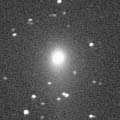
|
Although it had been rather large, well condensed, and easy to see until February, it became diffused in March. However, it still bright and large, 12.6 mag with a diameter of 2.4 arcmin on Apr. 1 (Kamil Hornoch). This is a bit brightern than this ephemeris, however, it is already fainter than 14 mag by CCD observations because the comet is diffused. So it will be invisible visually soon. In the Northern Hemisphere, it keeps the same altitude at 35 deg high in the evening sky until June when it fades down to 15 mag.
Date(TT) R.A. (2000) Decl. Delta r Elong. m1 Best Time(A, h)
Apr. 23 4 28.81 70 17.5 2.913 2.599 62 13.7 20:09 (156, 34)
Apr. 30 5 9.86 70 33.2 2.986 2.648 60 13.9 20:17 (156, 35)
|

|
Not observable. It will appear at dawn again in June. It had been always brighter than 13 mag and visible visually all through the season in 2004. In 2005, it is observable in very good condition, almost overhead in the Northern Hemisphere from summer to winter. It can be a good target of observaions if it becomes active as in 2004.
Date(TT) R.A. (2000) Decl. Delta r Elong. m1 Best Time(A, h)
Apr. 23 1 17.34 16 17.4 6.721 5.740 11 13.8 3:47 (244, -7)
Apr. 30 1 22.83 16 52.6 6.702 5.741 16 13.8 3:37 (246, -5)
|
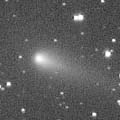
|
Although it had been strongly condensed until early January, it became diffused since late January. It is fading gradually, around 11.5 mag in January and around 12.5 mag in February. It was still bright at 12.6 mag on Mar. 8 (Seiichi Yoshida). Although the brightening evolution before the perihelion passage was extremely rapid, the fading after the perihelion passage is slow as expected. However, it became faint as 13.3 mag on Mar. 29 (A. Baransky), so it is getting hard to see visually.
Date(TT) R.A. (2000) Decl. Delta r Elong. m1 Best Time(A, h)
Apr. 23 5 52.88 18 13.4 2.876 2.452 55 13.8 20:09 ( 92, 30)
Apr. 30 6 5.92 18 18.1 2.973 2.482 51 14.0 20:17 ( 95, 26)
|
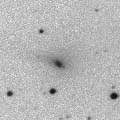
|
It brightened rapidly in January and reached to 13 mag. It was 12.8 mag, small as 0.9 arcmin, and unexpectedly rather well condensed (Mar. 8, Seiichi Yoshida). It has passed the perihelion in late February, and it is fading now. Although it was still bright as 13.2 mag on Mar. 31 (Edwin van Dijk), it will be invisible visually in May.
Date(TT) R.A. (2000) Decl. Delta r Elong. m1 Best Time(A, h)
Apr. 23 6 30.82 26 50.4 1.656 1.515 64 13.9 20:09 ( 96, 42)
Apr. 30 6 55.58 27 33.4 1.726 1.550 62 14.1 20:17 ( 99, 40)
|
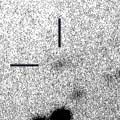
|
It has been brightening rapidly as expected, 19 mag in January and 17 mag in February, and reached to 15.5 mag in mid April. It keeps visible as bright as 12-13 mag for a long time from May to September. The condition is good in the Southern Hemisphere, but it locates very low in the Northern Hemisphere. In the previous return, it was 1.5 mag brighter than this ephemeris visually. So it can be around 11.0 mag visually at best in this return, too. It is getting bright enough to be visible visually. But it becomes lowest for the northern observers at 15 deg high from mid April to the end of June. So it will be easier to see visually in July and August.
Date(TT) R.A. (2000) Decl. Delta r Elong. m1 Best Time(A, h)
Apr. 23 16 2.36 -38 39.2 0.954 1.857 142 14.3 1:59 ( 0, 16)
Apr. 30 16 2.93 -39 33.4 0.890 1.823 147 14.0 1:32 ( 0, 15)
|

|
It will reach to 9 mag in 2006 spring. In the Southern Hemisphere, it keeps observable until that. In the Northern Hemisphere, it is not observable until 2006 March, except it appears very low in the morning at 12 mag from late August to early September. After 2006 March, northern people can observe it for a long time while it is getting fainter. It had been brightening well as expected until 2005 March. After that, recent brightness is uncertain because it became unobservable in the Northern Hemisphere.
Date(TT) R.A. (2000) Decl. Delta r Elong. m1 Best Time(A, h)
Apr. 23 4 17.92 -14 36.8 4.537 3.864 43 14.7 20:09 ( 78, -8)
Apr. 30 4 21.37 -14 30.5 4.509 3.798 40 14.6 20:17 ( 82,-14)
|

|
A comet with a retrograde orbit passed the perihelion at the end of March, and it also became closest to the earth at opposition at the same time, then it became bright momentarily while passing each other. Actually it did not became as bright as expected, however, it reached to 13.9 mag on Apr. 4 by CCD observation (Mitsunori Tsumura). It must have been visible visually too, but no visual observations were reported probably due to the low altitude. It will fade out rapidly after this. It will be too low in the evening sky at 16 mag in May, so it immediately becomes unobservable.
Date(TT) R.A. (2000) Decl. Delta r Elong. m1 Best Time(A, h)
Apr. 23 9 6.80 -12 19.0 1.522 2.067 108 14.6 20:09 ( 23, 40)
Apr. 30 8 52.15 -8 35.1 1.691 2.081 97 14.9 20:17 ( 39, 38)
|
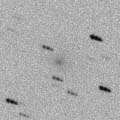
|
The component A had kept bright as 12 mag since Feb. 27 until Apr. 2 when it has passed 1 month after the perihelion passage (Michael Jager). In its previous return, the component A became brightest about 10 days after the perihelion passage. The observations in this return seem to coincide with the trend well. The brightness is a bit brighter than its previous return. However, it seems to start fading already. It was 13.1 mag on Apr. 4 (A. Baransky). It will fade out very rapidly after this, and will be fainter than 16 mag at the end of April. The condition of this appearance is bad. In the Northern Hemisphere, it becomes highest in April, but only 19 deg high. It locates lower in the Southern Hemisphere. Note that the actual position is somewhat off from the original prediction. The component D has not been detected yet.
Date(TT) R.A. (2000) Decl. Delta r Elong. m1 Best Time(A, h)
Apr. 23 5 2.23 16 8.5 1.644 1.149 43 14.6 20:09 ( 97, 19)
Apr. 30 5 33.81 16 0.1 1.722 1.227 44 15.3 20:17 ( 97, 18)
|
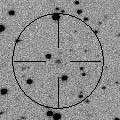
|
It has been brightening as expected, 16.5 mag in early February and 15.5 mag in early April. It will be observable in good condition at 14.5-15 mag until mid July. If the sky is clear, it may be visible visually at 14 mag, too.
Date(TT) R.A. (2000) Decl. Delta r Elong. m1 Best Time(A, h)
Apr. 23 17 25.22 9 48.3 2.791 3.467 124 15.1 3:22 ( 0, 65)
Apr. 30 17 10.94 11 25.1 2.697 3.454 132 15.0 2:40 ( 0, 66)
|
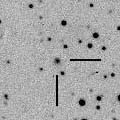
|
It brightened from 18 to 15 mag during one year from the end of 2003 to early 2005. The brightness evolution was much faster than that of a typical comet. It will become too low in the evening at 15 mag in June. Then it can be 13 mag and may be visible visually in next winter. However, after it reached to 15.2 mag in December and January at opposition, it is getting a bit fainter and 15.5 mag still in March, although it should have brighten slowly by calculation.
Date(TT) R.A. (2000) Decl. Delta r Elong. m1 Best Time(A, h)
Apr. 23 5 54.42 46 28.0 6.276 5.824 59 15.1 20:09 (124, 41)
Apr. 30 6 1.14 46 21.4 6.333 5.801 54 15.1 20:17 (126, 36)
|

|
It is moving northwards and getting observable also in the Northern Hemisphere. It is expected to be bright as 10 mag in early 2006. In the Southern Hemisphere, it keeps locating high until November while the comet is getting brighter gradually. In the Northern Hemisphere, it keeps locating very low around 15 deg high until September. So, it may be too hard to see visually for a long time.
Date(TT) R.A. (2000) Decl. Delta r Elong. m1 Best Time(A, h)
Apr. 23 20 23.51 -35 49.0 3.840 4.022 93 15.4 3:47 (329, 11)
Apr. 30 20 27.99 -35 56.8 3.673 3.954 98 15.2 3:37 (332, 12)
|

|
It brightened rapidly from 19 to 17 mag in early 2004. But it is in normal state now, brightening gradually. It was 15.7 mag on Apr. 9. It keeps 15-16 mag for a long time until early 2007.
Date(TT) R.A. (2000) Decl. Delta r Elong. m1 Best Time(A, h)
Apr. 23 16 2.77 -19 35.0 2.344 3.256 150 15.3 1:59 ( 0, 35)
Apr. 30 15 59.02 -19 39.6 2.288 3.244 157 15.2 1:28 ( 0, 35)
|

|
New bright periodic comet discovered in 2004 spring. In last year, it had been bright at 15.0-15.5 mag from spring to summer. The ephemeris says it keeps brighter than 19 mag even around the aphelion, however, the comet had not been discovered before 2004. This suggested the comet became bright temporarily last year. But actually, it keeps the brightness for more than one year until now, 15.3 mag on Mar. 11. In this year, it is expected to be as bright as last year from spring to autumn. It may be also visible visually at 14 mag.
Date(TT) R.A. (2000) Decl. Delta r Elong. m1 Best Time(A, h)
Apr. 23 20 10.63 -26 20.2 2.681 2.924 93 15.3 3:47 (327, 20)
Apr. 30 20 16.78 -26 42.6 2.596 2.932 99 15.2 3:37 (329, 21)
|
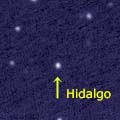
|
It reached to 13 mag and was observed visually in good condition in 2004 autumn. Then it has been fading on and on while being apart from the earth. It will be low in the evening sky at 16.5 mag in August. It will be observable again in 2006, at 16.5 mag from March to April, then it will go away. Next return is in 2018, when it will be 14.3 mag at best.
Date(TT) R.A. (2000) Decl. Delta r Elong. m1 Best Time(A, h)
Apr. 23 5 51.76 60 22.9 2.404 2.150 63 15.5 20:09 (143, 42)
Apr. 30 6 23.19 59 28.9 2.469 2.179 61 15.6 20:17 (142, 41)
|
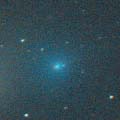
|
It was bright and large in early January, 11 mag and 2-5 arcmin, however, it has been fading rapidly as 12.5 mag in February and 13.3 mag in March. It was still visible visually on Apr. 5, but so faint as 13.8 mag (Seiichi Yoshida). It must be already too faint to see visually. It is already so faint as 16.4 mag on even by CCD observation (Apr. 16, Mitsunori Tsumura). It will be fainter than 18 mag in June.
Date(TT) R.A. (2000) Decl. Delta r Elong. m1 Best Time(A, h)
Apr. 23 12 17.68 18 20.6 1.155 2.029 139 15.5 22:11 ( 0, 73)
Apr. 30 12 16.94 17 16.6 1.240 2.073 134 16.0 21:42 ( 0, 72)
|
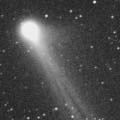
|
Fading gradually as predicted. It had been visible visually at 14 mag until January. But it became too faint to see visually after February. It will be 17 mag in June.
Date(TT) R.A. (2000) Decl. Delta r Elong. m1 Best Time(A, h)
Apr. 23 9 25.73 -4 53.2 4.626 5.078 111 15.9 20:09 ( 19, 48)
Apr. 30 9 24.01 -4 10.9 4.807 5.149 104 16.0 20:17 ( 32, 46)
|

|
Peculiar comet which becomes brightest about 5 months after the perihelion passage. It became brightest in February, about 5 months after the perihelion passage, as expected. However, it is fainter than expected in this return, and reaches to 15.5 mag at best. It was not visible visually, fainter than 14.0 mag (Feb. 5, Seiichi Yoshida).
Date(TT) R.A. (2000) Decl. Delta r Elong. m1 Best Time(A, h)
Apr. 23 10 6.64 31 43.9 2.517 2.989 108 16.2 20:09 ( 30, 86)
Apr. 30 10 9.79 31 1.3 2.620 3.008 102 16.3 20:17 ( 68, 80)
|

|
Recovery of a peculiar asteroid 2004 FS101 discovered in 2004 spring. Although it was 18 mag in mid January, it brightened to 16.7 mag in mid March. The brightness evolution was rather faster than that of a typical comet. It will be 14.5 mag around 2006 January, although it will be rather low for the northern observers. It keeps observable at 15-16 mag for a long time from 2005 spring to the end of 2006. Because it moves in the northern sky, it keeps observable for a long time in the Northern Hemisphere.
Date(TT) R.A. (2000) Decl. Delta r Elong. m1 Best Time(A, h)
Apr. 23 14 2.19 45 0.8 3.673 4.298 122 16.3 23:54 (180, 80)
Apr. 30 13 54.69 46 23.0 3.684 4.256 118 16.3 23:19 (180, 79)
|
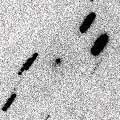
|
It came closer to the earth and reached to 15.5-16 mag from January to March by CCD observations. It was also visible visually at 14.3 mag (Feb. 6, Reinder J. Bouma). However, it will be getting apart from the earth after this, and getting fainter on and on. Although it is still bright as 16.5 mag in mid April, it will be fainter than 18 mag in June.
Date(TT) R.A. (2000) Decl. Delta r Elong. m1 Best Time(A, h)
Apr. 23 9 10.74 29 59.7 1.638 2.038 98 16.7 20:09 ( 73, 75)
Apr. 30 9 22.46 27 18.0 1.723 2.065 94 16.8 20:17 ( 73, 70)
|
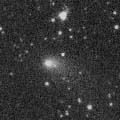
|
It had been fading rather faster than usual since the perihelion passage in 2004 spring. However, the fading turned to be slow after the end of 2004. It was already 15.4 mag on Dec. 16, then it kept almost constant brightness and 15.8 mag still on Mar. 6 (Akimasa Nakamura). It may be observable at 16 mag for a while after this. It still keeps bright as 16.7 mag on Mar. 26 (Ken-ichi Kadota).
Date(TT) R.A. (2000) Decl. Delta r Elong. m1 Best Time(A, h)
Apr. 23 9 47.36 36 2.0 4.204 4.534 102 16.9 20:09 (101, 84)
Apr. 30 9 47.05 35 0.4 4.370 4.600 96 17.0 20:17 ( 94, 77)
|
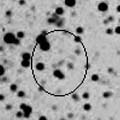
|
Because it is a far object, it has been observed at 17.5 mag for one and a half year since 2003 summer. It has already passed the perihelion, so it will become a bit fainter this year. But it keeps 18 mag until summer.
Date(TT) R.A. (2000) Decl. Delta r Elong. m1 Best Time(A, h)
Apr. 23 15 59.10 43 58.2 6.813 7.334 117 17.8 1:56 (180, 81)
Apr. 30 15 51.31 44 21.2 6.823 7.350 118 17.8 1:20 (180, 81)
|

|
Split comets. It will be fainter than 18 mag soon. The component B is fainter than A by 0.6 mag.
Date(TT) R.A. (2000) Decl. Delta r Elong. m1 Best Time(A, h)
Apr. 23 9 11.02 37 32.6 4.209 4.420 95 17.9 20:09 (105, 77)
Apr. 30 9 14.05 36 48.9 4.308 4.423 89 17.9 20:17 (102, 70)
|
|
![]()
 C/2003 K4 ( LINEAR )
C/2003 K4 ( LINEAR ) 161P/2004 V2 ( Hartley-IRAS )
161P/2004 V2 ( Hartley-IRAS ) 10P/Tempel 2
10P/Tempel 2 32P/Comas Sola
32P/Comas Sola C/2004 Q1 ( Tucker )
C/2004 Q1 ( Tucker ) 29P/Schwassmann-Wachmann 1
29P/Schwassmann-Wachmann 1 78P/Gehrels 2
78P/Gehrels 2 49P/Arend-Rigaux
49P/Arend-Rigaux 37P/Forbes
37P/Forbes C/2004 B1 ( LINEAR )
C/2004 B1 ( LINEAR ) C/2004 L1 ( LINEAR )
C/2004 L1 ( LINEAR ) 141P/Machholz 2
141P/Machholz 2 C/2004 K1 ( Catalina )
C/2004 K1 ( Catalina ) C/2003 WT42 ( LINEAR )
C/2003 WT42 ( LINEAR ) C/2005 E2 ( McNaught )
C/2005 E2 ( McNaught ) 117P/Helin-Roman-Alu 1
117P/Helin-Roman-Alu 1 P/2004 F3 ( NEAT )
P/2004 F3 ( NEAT ) (944) Hidalgo
(944) Hidalgo 62P/Tsuchinshan 1
62P/Tsuchinshan 1 C/2002 T7 ( LINEAR )
C/2002 T7 ( LINEAR ) 121P/Shoemaker-Holt 2
121P/Shoemaker-Holt 2 C/2005 B1 ( Christensen )
C/2005 B1 ( Christensen ) C/2004 RG113 ( LINEAR )
C/2004 RG113 ( LINEAR ) C/2003 T3 ( Tabur )
C/2003 T3 ( Tabur ) C/2003 O1 ( LINEAR )
C/2003 O1 ( LINEAR ) P/2004 V5 ( LINEAR-Hill )
P/2004 V5 ( LINEAR-Hill )![]()





















